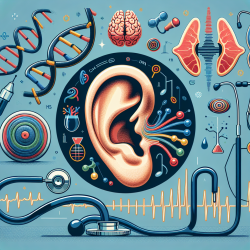Introduction
Auditory neuropathy (AN) is a complex hearing disorder characterized by the disruption of auditory nerve activity. This condition can significantly impair speech perception, making diagnosis and treatment challenging for practitioners. Recent research, such as the study "Information from cochlear potentials and genetic mutations helps localize the lesion site in auditory neuropathy," provides valuable insights into the genetic underpinnings of AN, offering new avenues for diagnosis and treatment.
Understanding Auditory Neuropathy
AN is marked by the disruption of temporal coding of acoustic signals, which results in impaired auditory perceptions. This disorder can be caused by lesions in the auditory nerve, inner hair cells, or their synapses. Despite preserved outer hair cell activities, patients often experience severe speech perception difficulties. AN can be either congenital or acquired, with various genetic and non-genetic etiologies.
Genetic Insights into Auditory Neuropathy
The research highlights the role of genetic mutations in both isolated and non-isolated forms of AN. Key genes such as OTOF, DIAPH3, and OPA1 have been identified as contributors to the disorder. Understanding these genetic mutations can help localize the lesion site, which is crucial for effective diagnosis and treatment.
- OTOF: Mutations in this gene are linked to presynaptic AN, affecting neurotransmitter release at the synapse.
- DIAPH3: Associated with autosomal dominant AN, mutations here affect the distal portions of auditory nerve fibers.
- OPA1: Mutations can lead to optic neuropathy and moderate deafness, affecting mitochondrial function and auditory nerve fibers.
Implementing Research Findings
Practitioners can enhance their diagnostic capabilities by integrating genetic testing into their evaluation of AN. Identifying specific gene mutations can help determine the lesion site and inform treatment strategies. For instance, cochlear implantation has shown promise in patients with presynaptic AN due to OTOF mutations, as it can bypass the affected synapse and restore speech perception.
Encouraging Further Research
While current findings are promising, further research is needed to explore the full spectrum of genetic mutations associated with AN. Practitioners are encouraged to stay informed about ongoing research and consider participating in studies that aim to refine diagnostic criteria and treatment options.
Conclusion
The integration of genetic insights into the diagnosis and treatment of auditory neuropathy represents a significant advancement in the field. By leveraging these findings, practitioners can improve their diagnostic accuracy and treatment outcomes, ultimately enhancing the quality of life for patients with AN.
To read the original research paper, please follow this link: Information from cochlear potentials and genetic mutations helps localize the lesion site in auditory neuropathy.










